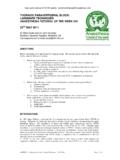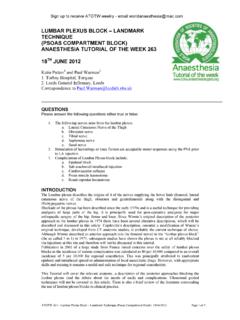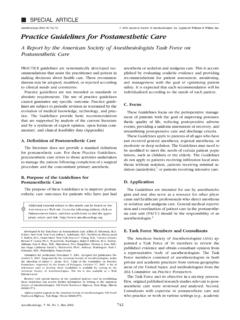Transcription of Complete spinal block after spinal anaesthesia - FRCA
1 Sign up to receive ATOTW weekly - email Complete spinal block FOLLOWING. spinal anaesthesia . anaesthesia TUTORIAL OF THE WEEK 180. 24TH MAY 2010. Bruce Newman, Anaesthetics Registrar Royal Hobart Hospital, Tasmania, Australia Correspondence to QUESTIONS. Before continuing, try to answer the following questions. The answers can be found at the end of the article, together with an explanation. True or False? 1. Complete spinal block is relatively common, occurring in ~1% of spinal anaesthetics 2. Complete spinal block is more common following labour epidural.
2 3. Increased intra-abdominal pressure has been associated with high spinal block . 4. Hypotension from high or Complete spinal block should be managed with trendelenberg (head down) positioning. 5. Spine imaging (to look for anatomical abnormalities) should be performed following a Complete spinal block event. INTRODUCTION. This article aims to describe the epidemiology, mechanism, risk factors and management of Complete spinal block following spinal anaesthesia (SA). High or Complete spinal block is a known complication of SA.
3 Defining what constitutes a high spinal is difficult. Clinical block well above the level required for surgical anaesthesia could constitute high' block , however, in the absence of significant sequelae (such as respiratory compromise or bradycardia) this would be considered an acceptable result. Complete spinal block is not well defined in the literature. The terms Complete ' or total imply anaesthetic block involving the cervical spine and above (such as brain stem and cranial nerves). The clinical manifestations of Complete spinal block include some or all of the following: Table 1: Clinical manifestations of Complete spinal block CARDIO- RESPIRATORY NEUROLOGICAL.
4 Hypotension* Nausea and anxiety*. Bradycardia* Arm/hand dysaesthesia or paralysis*. Respiratory compromise* High sensory level block . Apnoea* Cranial nerve involvement Reduced oxygen saturation Loss of consciousness*. Difficulty speaking/coughing Cardiac arrest (asystole). *Commonly reported or classical . Symptoms and signs usually occur within minutes of SA placement, however, delay up to 30 minutes has been reported. Clinical progression usually occurs over the subsequent several minutes. Nausea and high sensory level block (>T1) may be early indicators.
5 ATOTW 180 Complete spinal block foll, 24/05/10 Page 1 of 4. Sign up to receive ATOTW weekly - email EPIDEMIOLOGY. The incidence of Complete spinal block is unknown. There are numerous case reports and limited case series of this complication following SA. A recent Danish retrospective cohort study reviewing a total of 636 spinal anaesthestics for cesarean section did not record any instance of Complete spinal block requiring general This study included 128 spinal anaesthetics following the presence of a labour epidural.
6 High spinal block (which was not clearly defined) had an incidence of ~1%. There was no statistical difference in the incidence of high spinal block between those with or without prior labour epidural. A large 2009 central neuraxial complication audit in the United Kingdom did not include Complete or high spinal as a major complication. 2 Similarly, Swedish and French surveys on central neuraxial complications in the 1990's did not include separate incidence data on Complete or high spinal ,4 The UK and French studies included limited data on fatal cardio-respiratory collapse following spinal anaesthesia .
7 If Complete spinal were assumed to be the cause of all these events then extrapolation of this data would suggest the incidence of Complete spinal being <1/100,000 up to 27/100,000 ( ). MECHANISM & RISK FACTORS. Complete spinal block is caused by local anaesthetic interfering with the normal neuronal function in the cervical spinal cord and brain stem. The mechanism(s) behind this apparent effect are largely unknown and open to speculation. The numerous case reports and uncontrolled studies do not demonstrate a clear pattern.
8 Complete spinal block occurring following labour epidural is suggested by a number of authors to be a more common event, however, there is a substantial publication bias in this type of case report evidence. 6,7,9,10,11,12,13,14,15,16 In addition, there are several other studies that do not demonstrate an increased risk of Complete spinal block following labour epidural. 5,8 In general the following factors need to be considered in order to minimise the risk of high or Complete spinal block : 1. Drug factors a.
9 block height more dependent on dose than volume (higher dose gives higher risk). b. Baricity cephalad spread easier to control with hyperbaric solution c. Prior drug administration such as epidural local anaesthetic diffusion (unrecognised/sub-clinical block gives higher risk). 2. Patient factors a. Body morphology higher BMI or abdominal girth (including pregnancy) may reduce thecal volume and increase the risk of high block b. Anatomical or pathological factors compressed thecal sack (epidural fluid & dilated vessels), spinal canal abnormality can give higher risk 3.
10 Technique factors a. Higher lumbar insertion may increase final block height b. Position at and following injection sitting may minimise cephalad spread c. spinal needle finer gauge and cephalad direction of needle hole may increase risk of higher block Anecdotal evidence suggests the following are patient risk factors associated with high or Complete spinal ,7,9,10,11,12,13,14,15,16. Table 2: Patient risk factors for high or Complete spinal block 1. Prior epidural (especially recent top-up ). 2. Large local anaesthetic dose 3.
















